This is a versatile Arduino gas sensor equipped with an MQ2 probe. It can detect various gases such as LPG, i - butane, propane, methane, alcohol, hydrogen, and smoke. Ideal for gas leakage detection in both consumer and industrial markets, it offers high sensitivity and a fast response time. You can adjust the sensitivity using the potentiometer, and the output is proportional to the gas density. It allows for easy analog data reading. To simplify usage, it features a Gravity Interface for plug - and - play. The Arduino IO expansion shield is the perfect match for connecting it to your Arduino. Moreover, it can operate at 3.3V, making it compatible with Raspberry Pi, Intel Edison, Joule, and Curie. The sensor has several improvements, including a standard assembling structure with a 5mm center distance between two 3mm mounting holes, easily recognizable sensor interfaces ('A' for analog and 'D' for digital), icons to illustrate sensor functions, a high - quality connector, and an immersion gold surface. Specifications include a 5V power supply, an analog interface, a wide detecting scope, fast response, high sensitivity, a simple drive circuit, stability, long life, and a size of 36.4x26.6mm (1.4x1''). The shipping list includes one Arduino Gas Sensor (MQ2) and one Gravity Analog Cable.



Using this gas sensor is quite easy. First, connect it to your Arduino using the Gravity Analog Cable. If you have an Arduino IO expansion shield, it's the best way to go. Once connected, power it up with a 5V power supply. You can adjust the sensitivity using the potentiometer according to your needs. When using, place the sensor in an area where you want to detect gas. It will start detecting various gases like LPG, methane, etc. and give an output proportional to the gas density. You can read the data through analog reading. For maintenance, keep the sensor clean and dry. Avoid exposing it to extreme temperatures or harsh chemicals. Make sure the connections are always tight. When not in use, store it in a safe place. Also, be aware that although it's very sensitive, false readings can occur in a very dusty or humid environment. So, try to use it in a relatively clean environment.